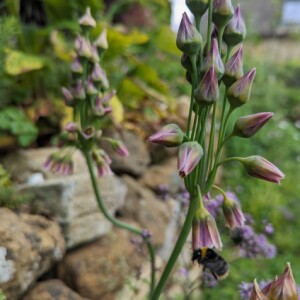Day of Wagging Tongues
Heroes and villains, and politics
Hypoderma bovis is a particularly unpleasant fly that is parasitic on cattle. It lays eggs directly on their hairs, typically on legs and feet. The emerging larva tunnels into the host flesh, then takes a leisurely year, dissolving muscles, nerves and organs, burrowing its way unobserved to the top of the animal's back. There it makes a breathing hole, pauses for a couple of months, emerges, and falls into the dirt, where it pupates, and the whole malign cycle begins again. Cattle recognise the sound of the insect and stampede dementedly around the pasture in a vain, terrified attempt to escape, putting themselves at risk of harm, as I have seen with my own eyes
After a rather dull admin & shopping day, I thought the invader in the extra would make a more interesting blip than anything I have done or thought about. "Invader" because it has spread by seed from our neighbours' garden - first planted, I expect, by the previous occupants, stalwarts of village life who have both died since we came to live here, so it's good to have an annual reminder of them. It is a mainly decorative form of garlic, called 'honey garlic' (Allium siculum) native to Europe, but not UK. It amuses us by having the bobbing, pendulous flowers, as at the bottom which, when they have been fertilised, revert to being erect and producing a seed pod in the form of the ones at the top
As you see, I was photo-bombed. But the bomber then went on to usurp the entire blip by working her way up the wall-top foxglove and (full confession: by pure chance) giving me this excellent display of the longest tongue in the bumblebee queendom. The mouth-parts consist of a two-part rigid sheath, comprised of the maxilla (above) and palp (below), between which lies the long, hairy tongue. I'm pretty sure this is Bombus hortorum, the 'garden bumble bee', which typically has a tongue 14mm long, but can be up to 20mm. The hairy tongue, of course, acts like a sponge and helps her drag nectar up from the base of the flower. Meanwhile, she performs the service of fertilising the flower - a benign partnership (Lots of geeky detail here)
The pestilential Hypoderma bovis has several common names, but the one taught to me by my grandfather, long before I ever heard the word 'metaphor', was "gadfly"


Comments
Sign in or get an account to comment.


